Halophytes: Salt Tolerant Plants
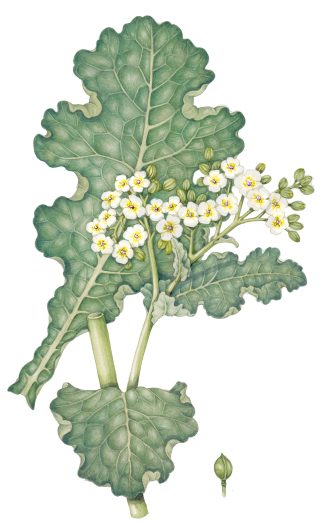
Halophytes: Salt Tolerant Plants
Halophytes are plants that tolerate or thrive in salty conditions. I recently finished the illustrations for a chart of seaside flowers, and got to wondering how these plants can survive in these hostile habitats? Another job, illustrating stamps for a Seaside flowers issue, added to my interest.
This blog had me scouring the internet, and getting more and more fascinated by what I found. However, I am no expert, and would refer interested readers to the bibliography at the end of the blog for references and further reading.
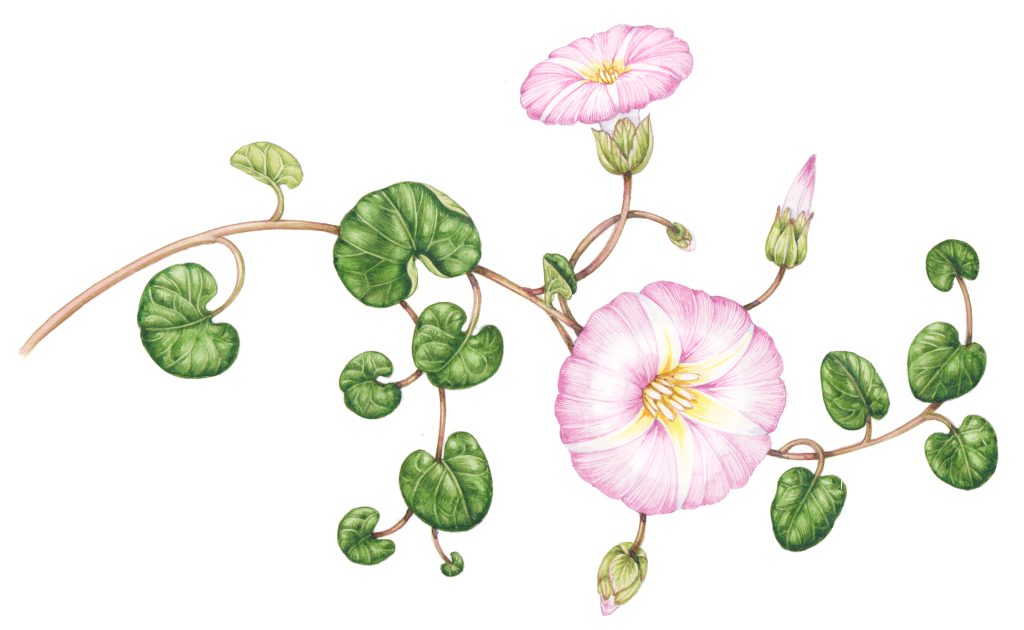
Sea Bindweed Calystegia soldanella
Salt damage
Salt damages most plants as it messes up the way cells absorb water. A plant which isn’t adapted for salty (or haline) conditions wouldn’t last long in a salt marsh or coastal area. Salt water can reduce plant growth and photosynthesis. It leads to an imbalance of nutrients and ions. It alters plant hormone production and action. Most obviously, it makes it hard for plants to regulate their water balance.
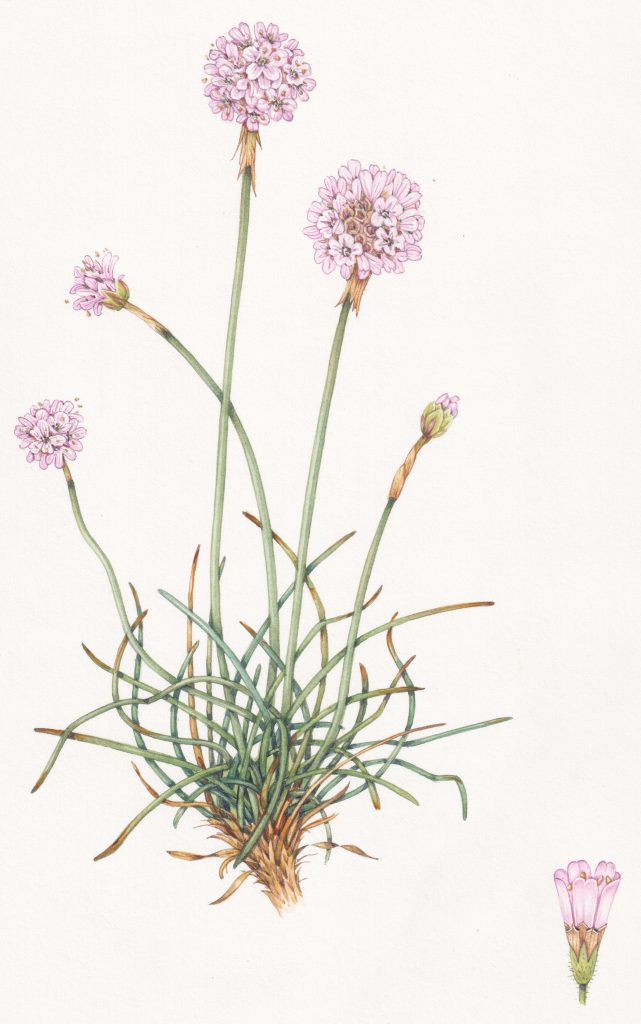
Thrift Armeria maritima
Halophytes
Some plants have evolved to survive these harsh conditions. These are the Halophytes. They can tolerate a range of salty environments, from salt-marshes to dry and salty deserts. Their adaptations help them shrug off the effects of salt spray, and allow them to live in soils saturated with salty water. It’s not every plant that can do this. Only 1 – 2 % of the world’s flora are halophytes. Of these, “only 0.25% are reportedly able to complete their life cycles in Saline soils” (Flowers et al 1990, New Phytologist 1990)
(Plants which can’t tolerate salt are called Glycophytes. This literally translates from the Latin as “Sweet loving plants”.)
Types of Halophyte
There are various classifications of Halophytes, mostly depending on what concentrations of salt they can survive. There are Obligate halophytes, plants which need salt to grow. An example of this is the Glasswort, Salicornia.
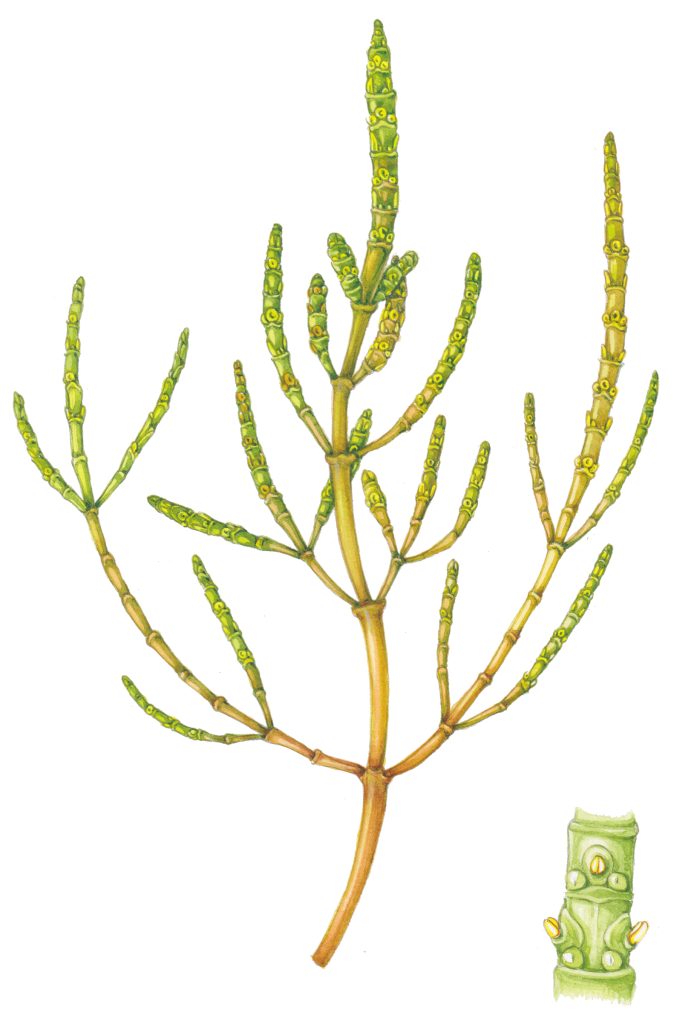
Common Glasswort Salicornia europaea
There are many more Faculative halophytes. These plants can tolerate salt, but will also thrive in non-salty conditions.
Some halophytes need wet soil or salt-marshes to survive. These are termed Hydro-halophytes. A mangrove tree is the most obvious example.
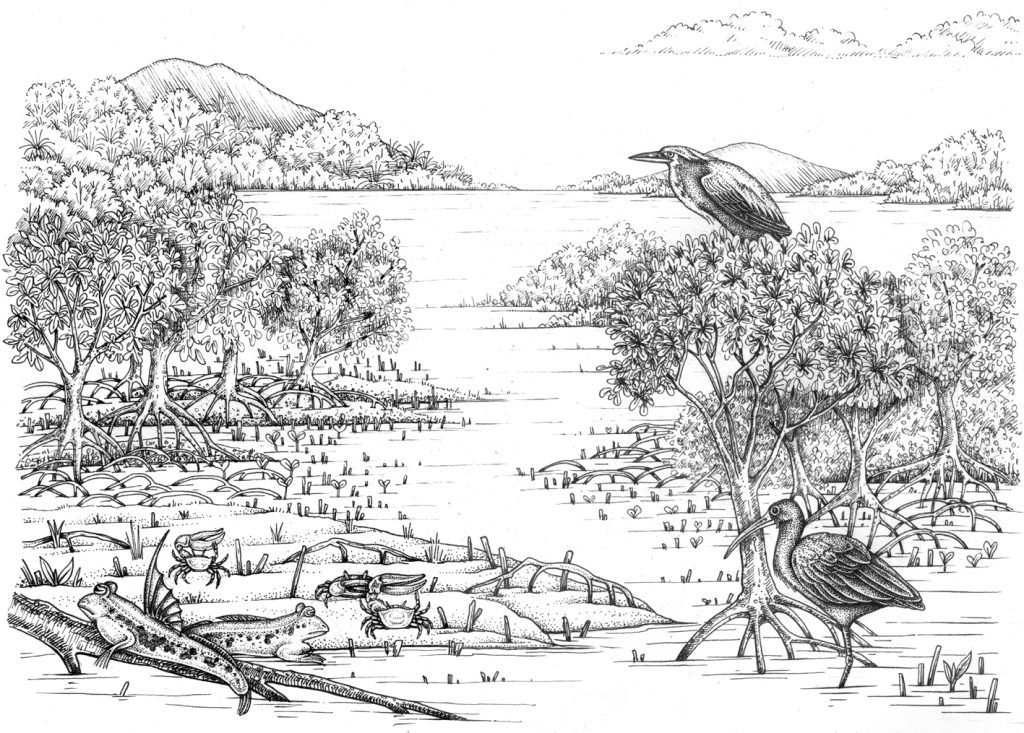
Mangrove swamp – a haline habitat
Xero-halophytes thrive in dry and salty soils, such as deserts. They can handle unpredictable rains as well as salty soils. The Frankincense tree is an example.
Adaptations to Saline environments
Although there aren’t an enormous number of halophytes, they’re distributed across lots of plant families. It’s believed that the adaptations needed to survive these inhospitable habitats have evolved independently on many occasions. The fact that so many species have ended up with similar coping mechanisms is yet another example of convergent evolution.
Adaptations: Being a Succulent
Lots of halophytes are succulents. This means that their stems and leaves are fleshy and watery. Succulent plants have fewer cells, and these cells are longer than those in other plants.
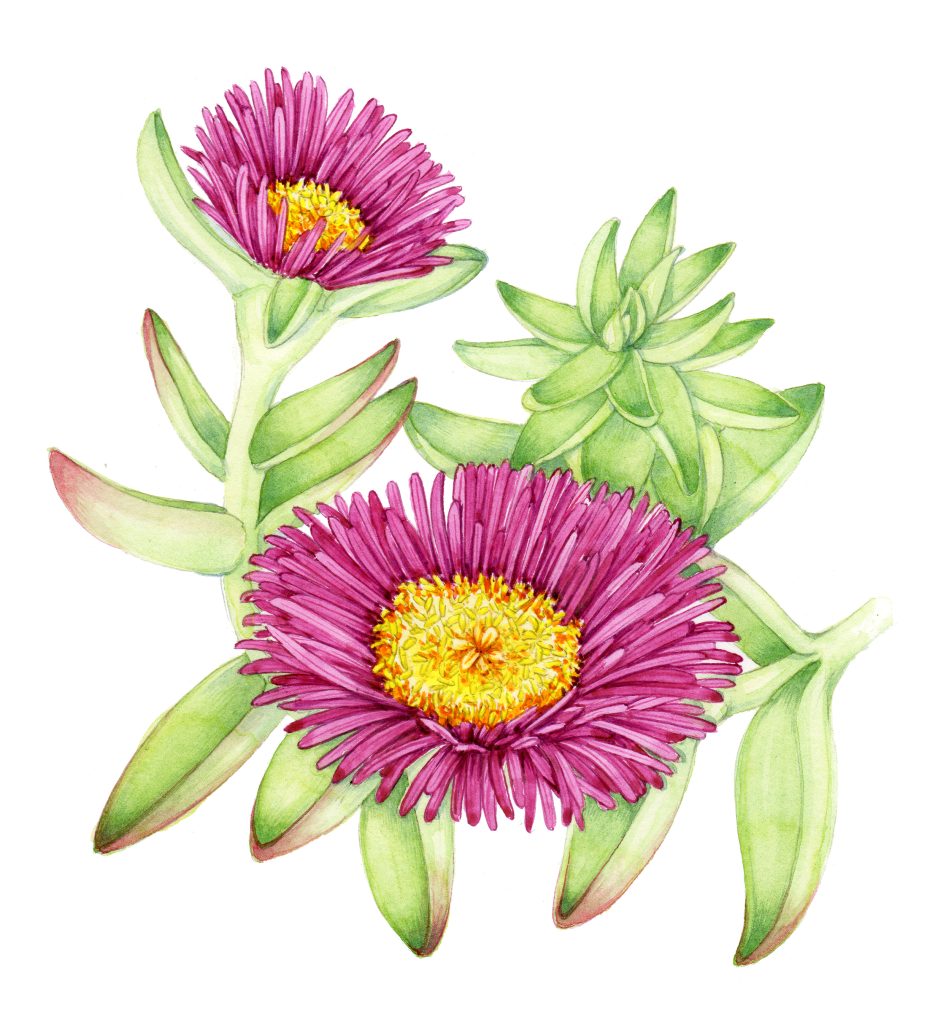
Hottentot fig Carpobrotus edulis
Salt absorbs water, so it’s vital to counteract this. In succulents, moisture is preserved using lots of these water bearing cells. These watery cells manage to dilute the concentration of salt in the sap of the cell. Thin cell walls allow each cell to swell and accommodate its watery burden.
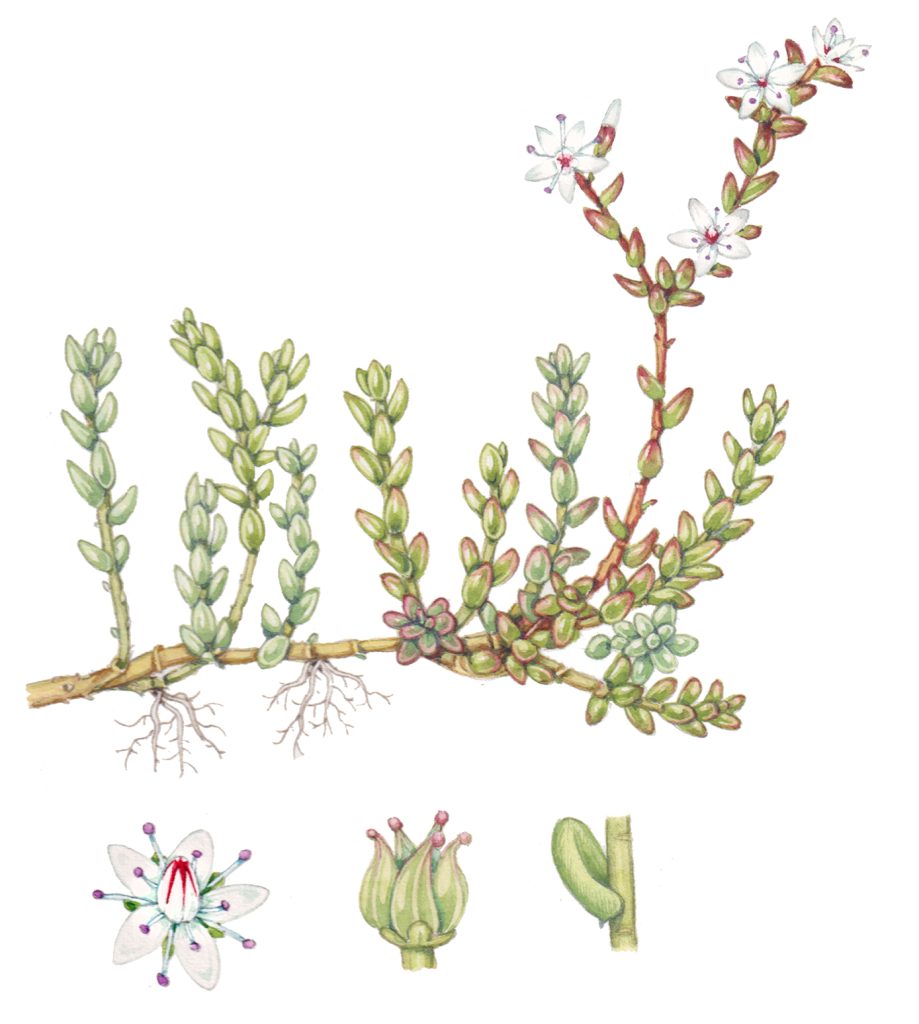
English stonecrop Sedum anglicum
Adaptations: Small leaves
Halophyte leaves are excellent at counter-acting the desiccating effects of salt. Many halophyte plants have tiny leaves. These have a small surface area, so less water is lost through transpiration. Lots of species have few and small stomata. Again, this helps the plant cling onto water.
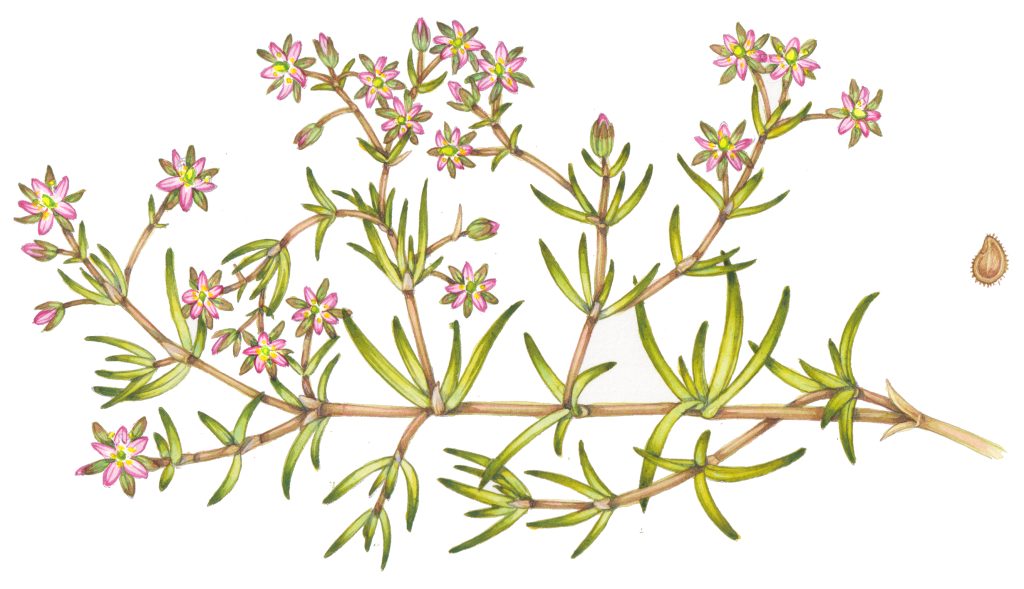
Lesser Sea spurrey Spergularia marina
Though small, leaves may be thick, and succulent. The ratio of water-storing space to surface area is high.
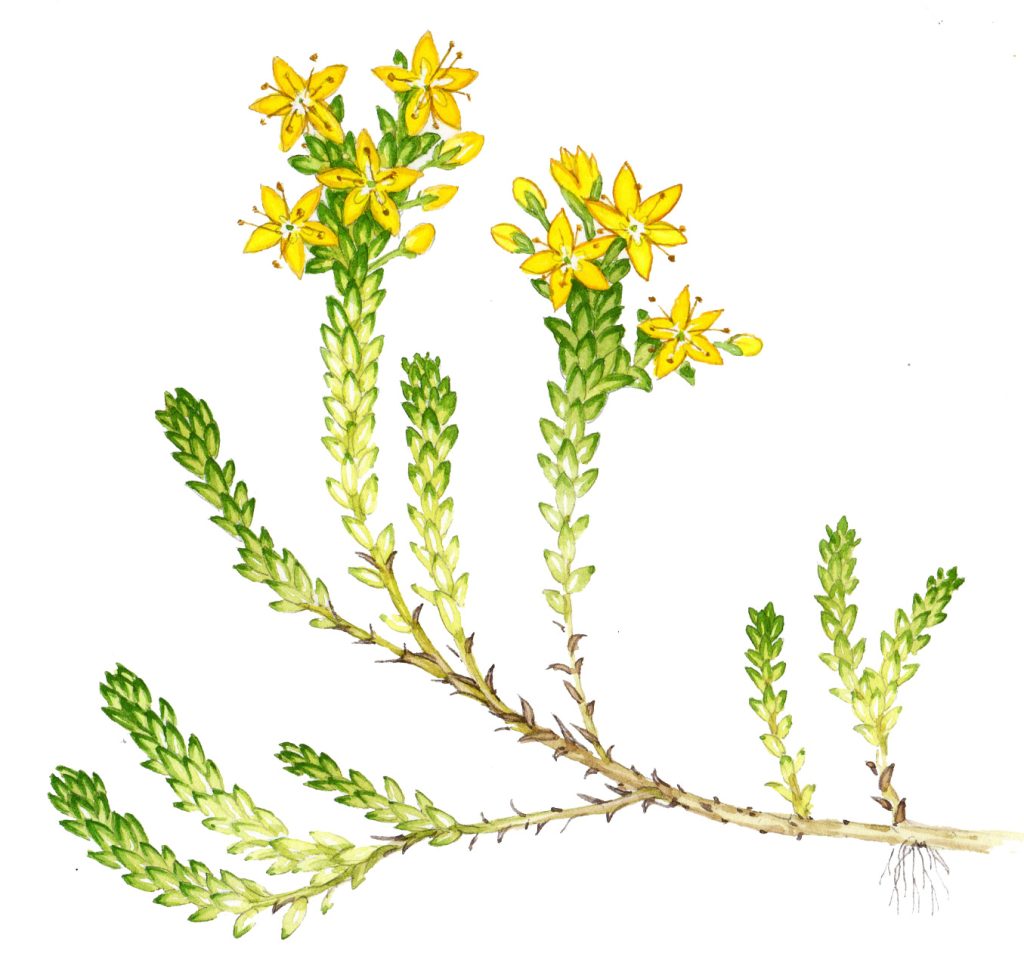
Biting Stonecrop Sedum acre
Thicker epidermal layers are seen in some halophytes, and many have a thick, waxy cuticle which helps to waterproof the leaves. However, just because plants (like sedums) have a thick waxy cuticle, this does not necessarily mean they can tolerate salty conditions. Some can, others can not.
Remember, leaves need to keep the water inside, but they also need to protect the plant from the external damage salt spray can inflict. The thicker epidermis and cuticle do both.
Some halophytic plants sport leaves with low levels of chlorophyll. Perhaps this contributes to the blue-ish hue of many of their leaves?
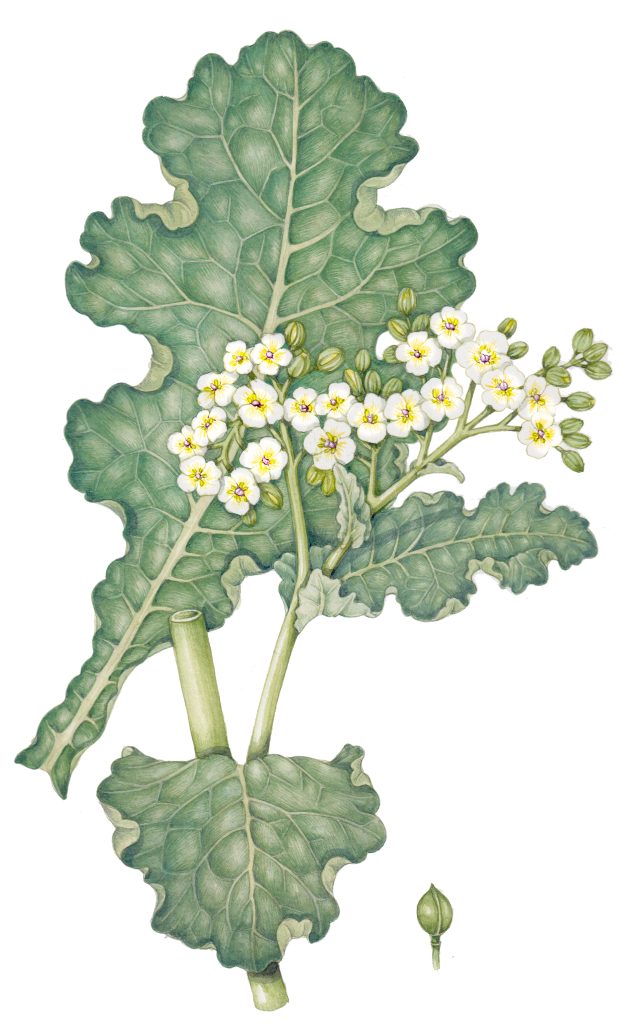
Sea Kale Crambe maritima
Adaptations: Secreting salt & Salt glands
Salt levels can be regulated using salt glands. These excrete salt, either direct onto the leaf surface, or into a discreet gland. These can be vacuoles of bladder cells, and are often hidden just below the surface of the epidermis. In some species, these glands burst; in others they break off and fall from the plant, carrying their toxic salt burden with them.
These salt bladders accommodate the build-up of salt or other ions, and allow a plant to exclude certain elements from its tissues.
Sea lavender species have salt glands just below the level of the epidermal cells.
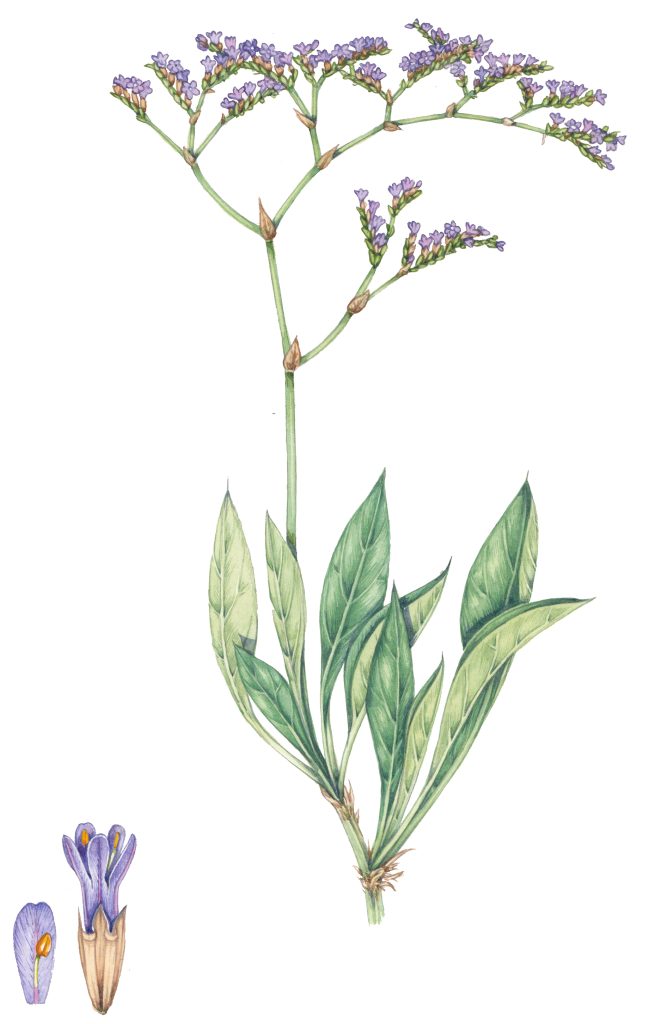
Sea Lavender Limonium vulgare
Salt glands may be specialised Trichomes (outgrowths from the epidermis of a plant). Lots of coastal plants have greyish blue stems and leaves. In many cases, they are covered with a wide variety of trichomes. Some are simple, some are un-branched. These not only affect leaf temperature and aid water economy, but contribute to that distinctive hue.
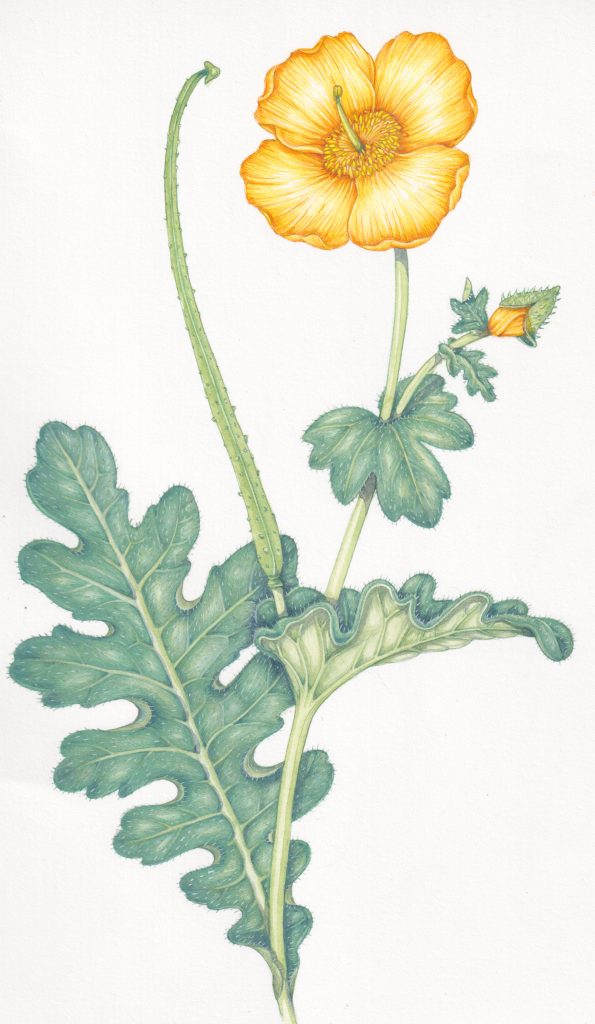
Yellow-horned Poppy Glaucium flavum
Adaptations: Tough seeds
Seeds of halophytes have been widely researched, and their viability and ability to germinate in salty conditions is amazing.
Many have thick and waxy seed coats. Seeds may be large. However, it is the hormonal regulation and patterns of germination which are most interesting.
Germination times are often very fast, and times of reproduction and germination can be tightly controlled by plant hormones. Recovery of germination after salt-stress or drought (in xerohylophtes) is rapid. Flowers and Colmer have done extensive research on this topic.
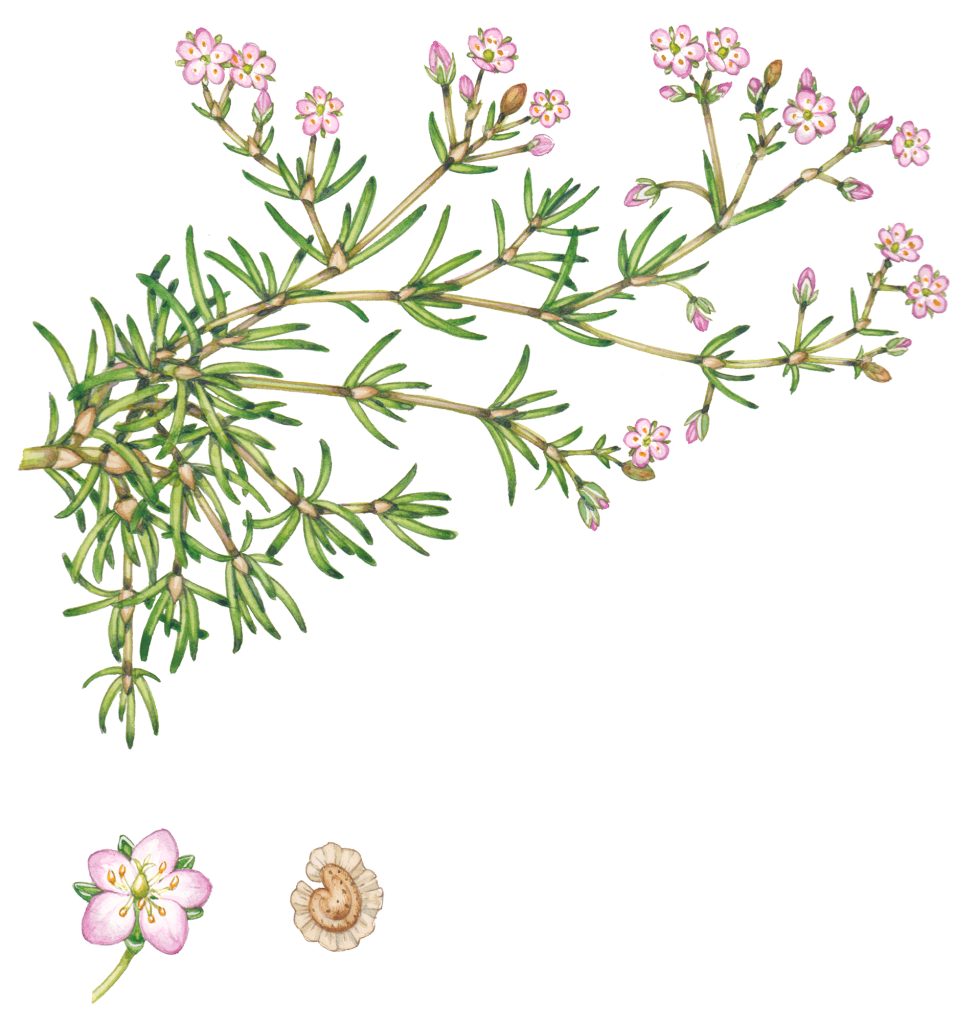
Greater Sea spurrey Spergularia media
Greater Sea spurrey, whose seed dormancy patterns have been examined extensively by Ungar.
Adaptations: Amazing roots
Roots have an important role to play in salt regulation. Some halophytes produce pneumatophores, structures which protrude from salty water into the air (see my blog on Root variety for more on this).
Other plants have extensive networks of roots which grow into less salty substrates. Adventitious roots allow for horizontal growth, which could allow a plant to grow directly above saltier soils.
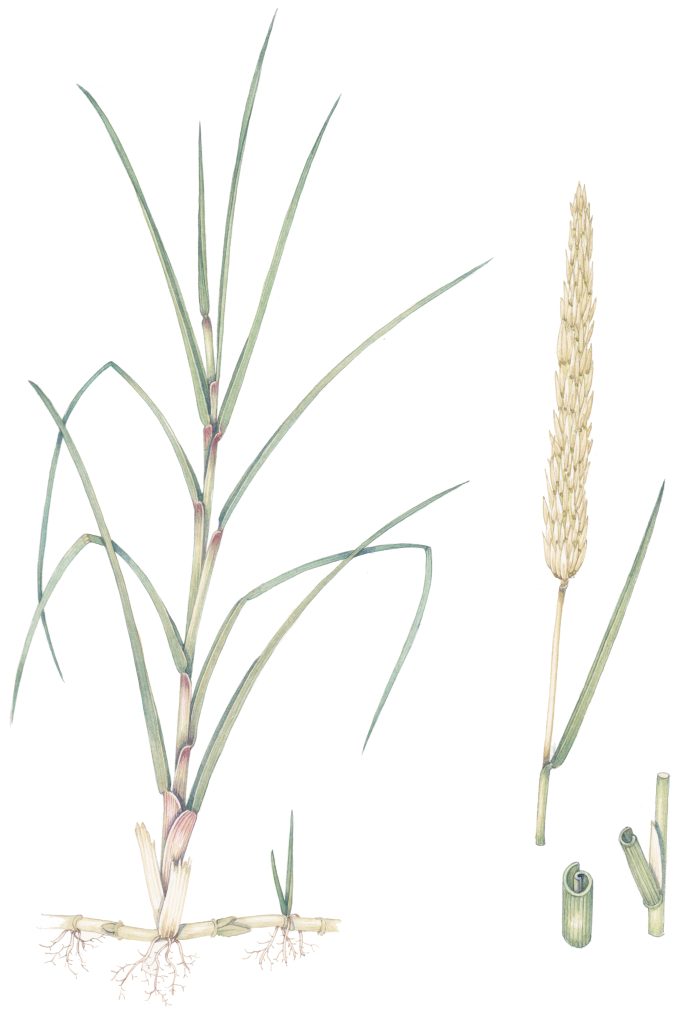
Marram grass Ammophila arenaria
Adaptations: Accumulate salt then die
A more extreme solution is just to accumulate salt…then die. Some rush (Juncus) species do this. They have no means of regulatiing their salt balance. However, this doesn’t seem to stop them from colonising salty environments and reproducing successfully.
Why choose a salty environment?
Having looked at adaptations to this hostile environment, one has to ask, “why grow there?” Clearly, the salt is problematic and has required an armory of evolutionary coping mechanisms. So why spend that energy to exploit such an environment?
Firstly, there’s not a lot of competition. As stated earlier, 95% of plants can’t survive saline habitats. That’s 95% less potential competitors for your niche.
Haline habitats may also be lower in predators, and may help keep numbers of vermin down. In the literature there’s also some suggestion that salty environments can help prevent disease, although I didn’t examine this fully.
Examples of Halophytes
So what plants are halophytes? It partly depends on your definition, but below are some examples.
In the grass family Poaceae, Marram grass and Cord Grass grow on salty sand dunes.
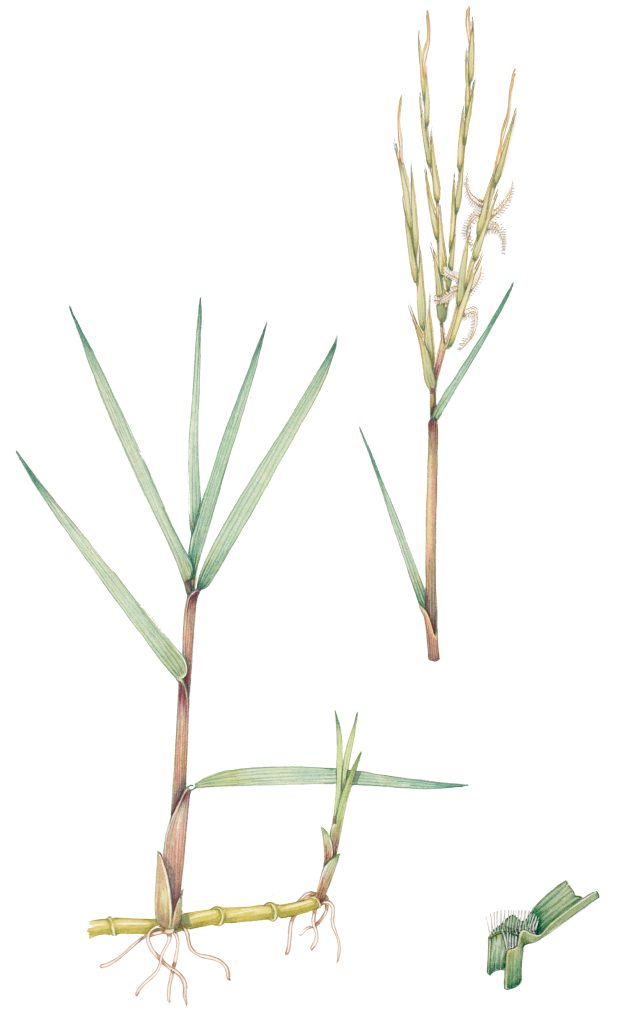
English Cord-grass Spartina anglica
The Amaranthaceae family includes the obligate halophyte Glasswort. It also includes Saltwort Salsola kali.
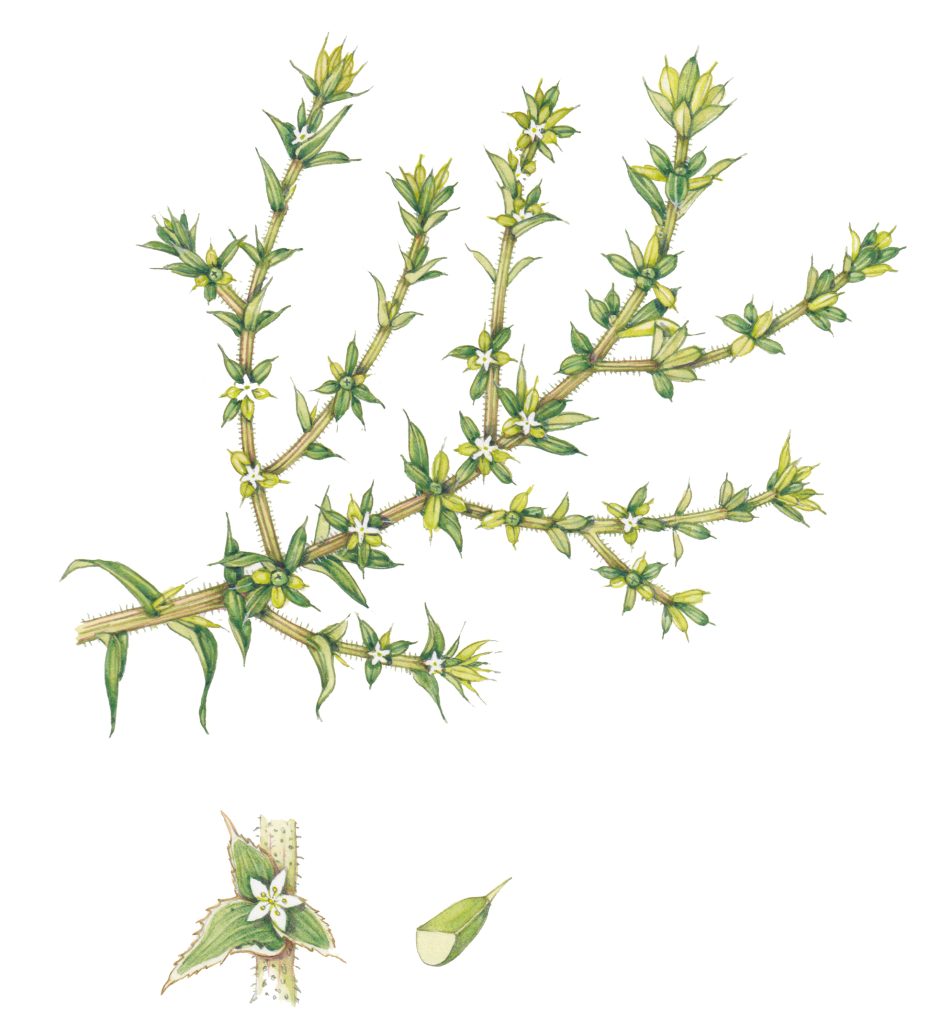
Saltwort
Other members of this family are Pig-weeds, Goose-foot, and Beet.
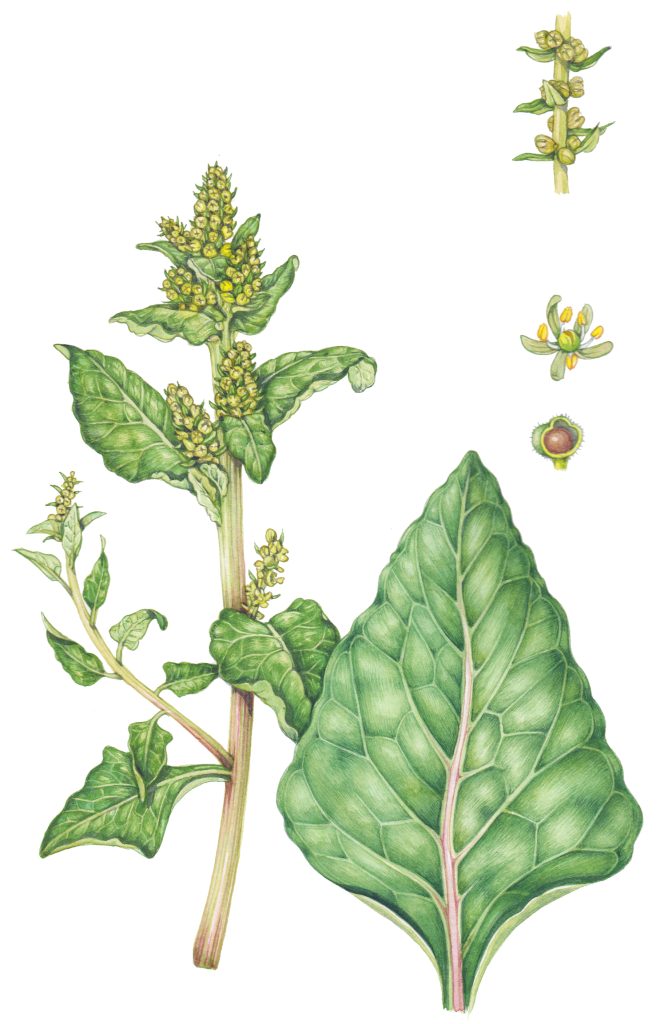
Sea Beet Beta vulgaris maritima
In the Plumbaginaceae family there’s Sea Lavender
In the Legumes we have the Sea pea, Lathyrus japonicus
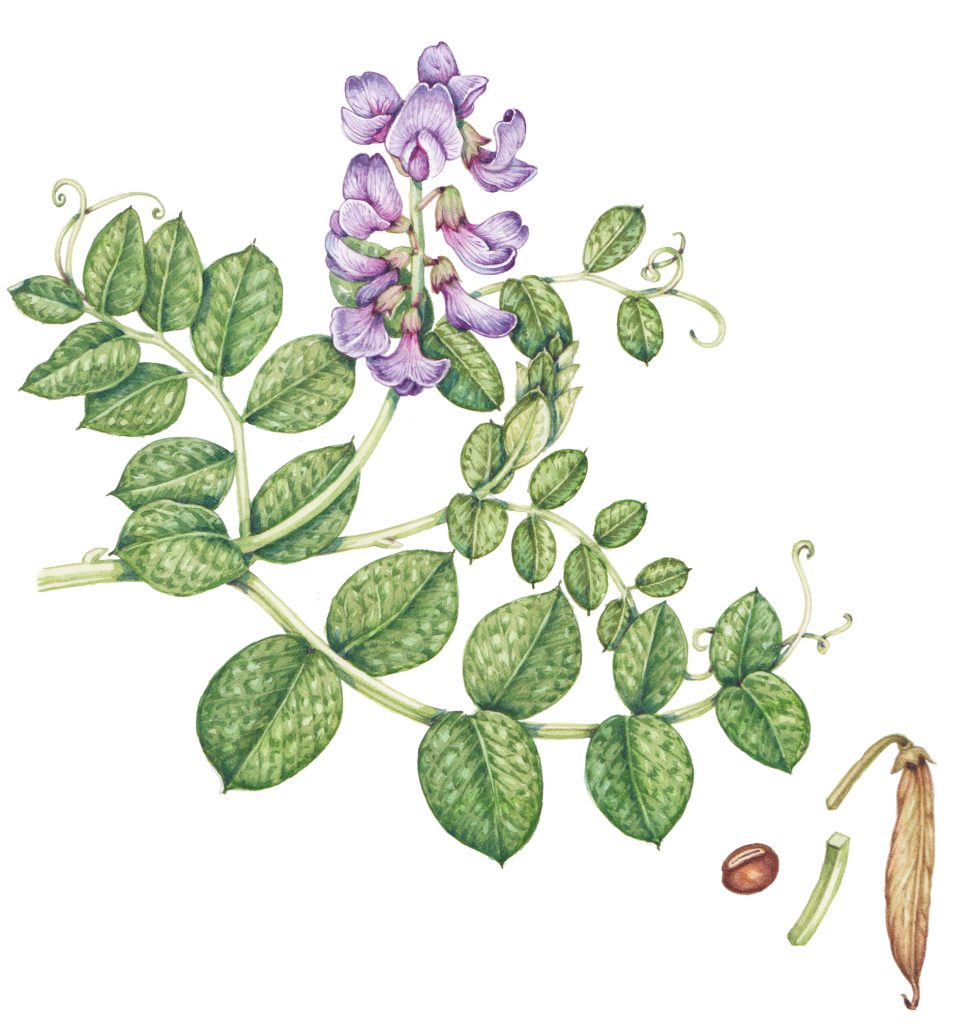
Sea pea Lathyrus japonicas
There are databases of halophytic plants, including the Halophyte Database and a list of salt-tolerant plants from the Biosalinity Awareness Project
Why are Halophytes so important in 2020?
Halophytes aren’t just fascinating plants. They could be vital to us humans, in our rapidly changing world. Most crops are glycophytes, and are salt-sensitive. With many places at increasing risk from rising sea levels, crops which are resistant to salty water could have an important role to play. Research is being done to see if cross-breeding and genetic modification could help develop new salt-resistant crop plants.
(Sea Sandwort, below, is edible. However, I found no evidence it was being trialled as a salt-resistant crop…as yet!)
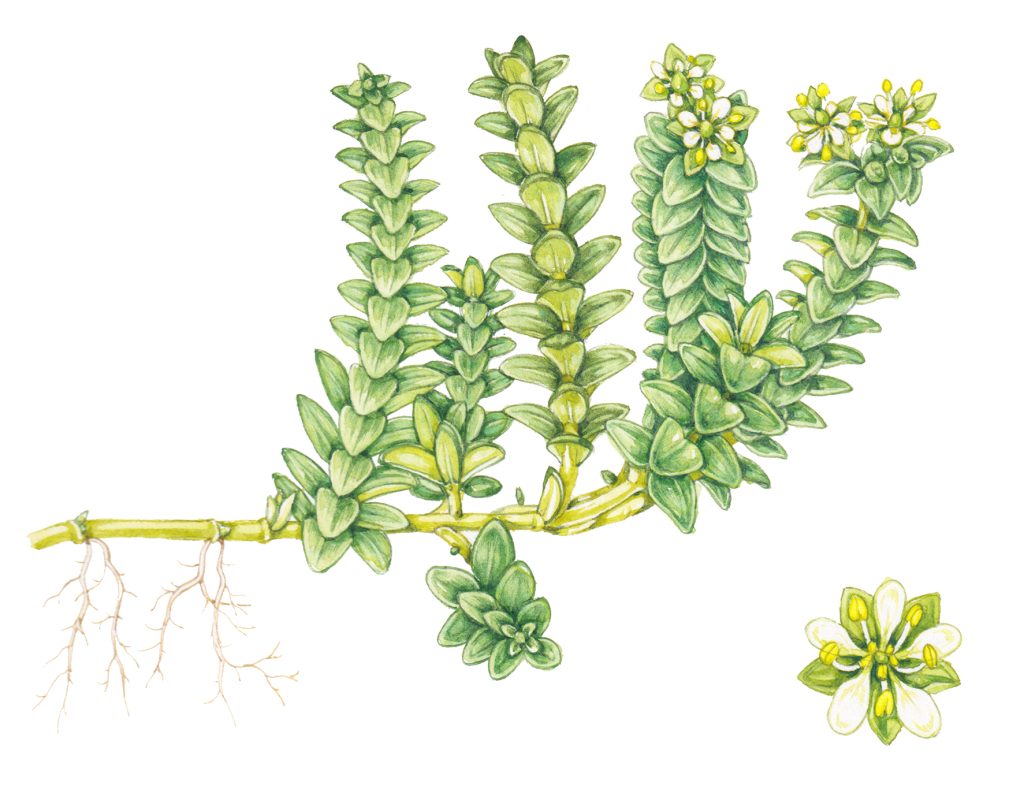
Sea Sandwort Hockenya peploides
Salt-affected and land made toxic with heavy metals areas could be cleaned with the help of halophytes. Some halophytes are able to regulate the ions entering their xylem stream. These ions include sodium and other elements. Scientists such as Lutts & Lefevre are researching their potential role as a way to clean heavy metals from the soil. (Lutts & Lefevre 2015 How can we take advantage of halophyte properties to cope with heavy metal toxicity in salt-affected areas? Annals of Botany 2015). Halophytes may prove vital in these processes of phytoremediation.
Ecologically, halophytes have an important role to play with land reclamation. Their networks of tough roots and ability to withstand tidal flooding make them perfect candidates to help re-colonise saline lands.
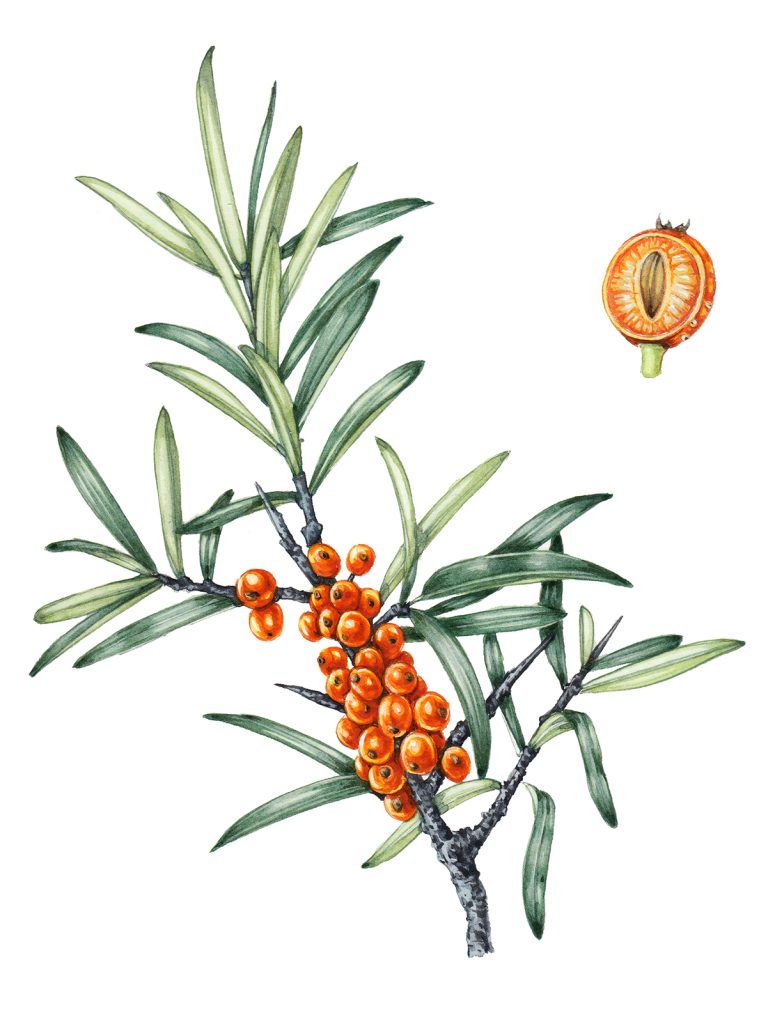
Sea buckthorn Hippophae rhamnoides
With halophytes helping humanity reclaim salty land, and produce salt-tolerant crops for a rising population in an environmentally changing world; I think it would be hard to over-estimate their importance to our future.
Conclusion
With their ingenious adaptations and ability to colonise salty habitats, halophytes are fascinating. Couple this with their potential as an important aid to humanity, and they become ever more deserving of our attention.
Below is a list of further reading. There are many nuances to current research which hasn’t been covered in this blog; issues relating to biochemistry and seed viability amongst them. Hopefully the bibliography below will allow an interested reader to pursue the topic further.
(Many of these original illustrations are available to buy, just search for them in by name in the “Original Illustrations for Sale” section of my website).
Bibliography
Colmer & Flowers, 2008 Salinity tolerance in halophytes New Phytologist 179
Gonzalez, 2019 Adaptation of Halophytes to Different Habitats DOI: 10.5772/intechopen 87056 link
Gupta, Halophyte Plants Biology Discussion
Lutts & Lefevre 2015 How can we take advantage of halophyte properties to cope with heavy metal toxicity in salt-affected areas? Annals of Botany 2015
Nikita, Halophytes: Classification and Characters of Halophytes Biology Discussion
Reddy, Halophytes: Meaning and Types Biology Discussion
Ungar, I. A. & Binet, P., Factors influencing seed dormancy in Spergularia media, Aquatic Botany, 1, 45, 1975.
Ventura & Sagi, 2015 The Development of Halophyte-based agriculture: past & present Annals of Botany 2015


Such beautiful artwork. I bet the scientific community loves you!
Hi Donna, Thanks so much for your comment. I hope some of the scientific community like what I do, but it’s always a challenge to learn and absorb new information, and to tighten up on the detail. I’m incredibly lucky to work with such inspiring and well-informed botanists! Thanks again, Lizzie
Lizzie I love this blog. I live on Whidbey Island in the Pacific Northwest of the USA and did my SBA study on the sea shore of the reserve here. Its so interesting as to what survives. Thanks for such a fascinating article.
Hi Deb, I bet you’d have loads more plants and information to add to my blog! I love how the plants are specific to different maritime habitats too – you’d never get sea kale on a cliff, or thrift in esturine mud banks. Best way to learn about these differences is to be out in amongst it all, which is exactly what you did for your SBA study. I’m jealous! Thanks for your comment. Whidbey Island sounds wonderful.
Wow, you are a triple threat — not only are you a great artist, you are a wonderful writer and horticulturalist. You also gave me an idea of how to deal with planting in an area where there are cremains — I’m going to try some stone crop/sedum.
Hi Susan
This is one of the best comments I’ve ever got. I love being thought of as a triple threat, how exciting! I’m so pleased you think my writing is ok, and I’ve managed to trick you into thinking I’m a decent botanist. Hah! But seriously, thankyou. And good luck with those sedums and stone crops. Pretty little plants for a space that required thought. So happy to be of help.
X Lizzie
Thank you very much, this was really interesting 🙂
Thanks, Sam. It was one of those blogs that I got more and more fascinated by the more I researched it. I’m glad it held your interest. x
Thank you so much for sharing detailed information about halophytes at one place!
My pleasure
Great and quality info, this helped me a lot! – Thank you!
Glad to hear it, and thanks for the comment
Awesome blog, very informative, thanks for sharing.
My pleasure. Thanks, David.
Very nice illustrations; however, some of the examples are no halophytes! as e.g. Mesems, or most Sedums.
Hello Siegmar
Thank you so much for this valuable input! I will tweak the text of the blog accordingly. Thank, I appreacite you taking the time to point out these mistakes. Yours Lizzie
Great info, – Thank you!
Thankyou!
Wonderful artwork regarding the halophytes. Haven’t come across anything like this piece of art across the web. You have done a highly commendable job.
Thank you so much! Its always a massive help when there are botanists working alongside me. Thank you